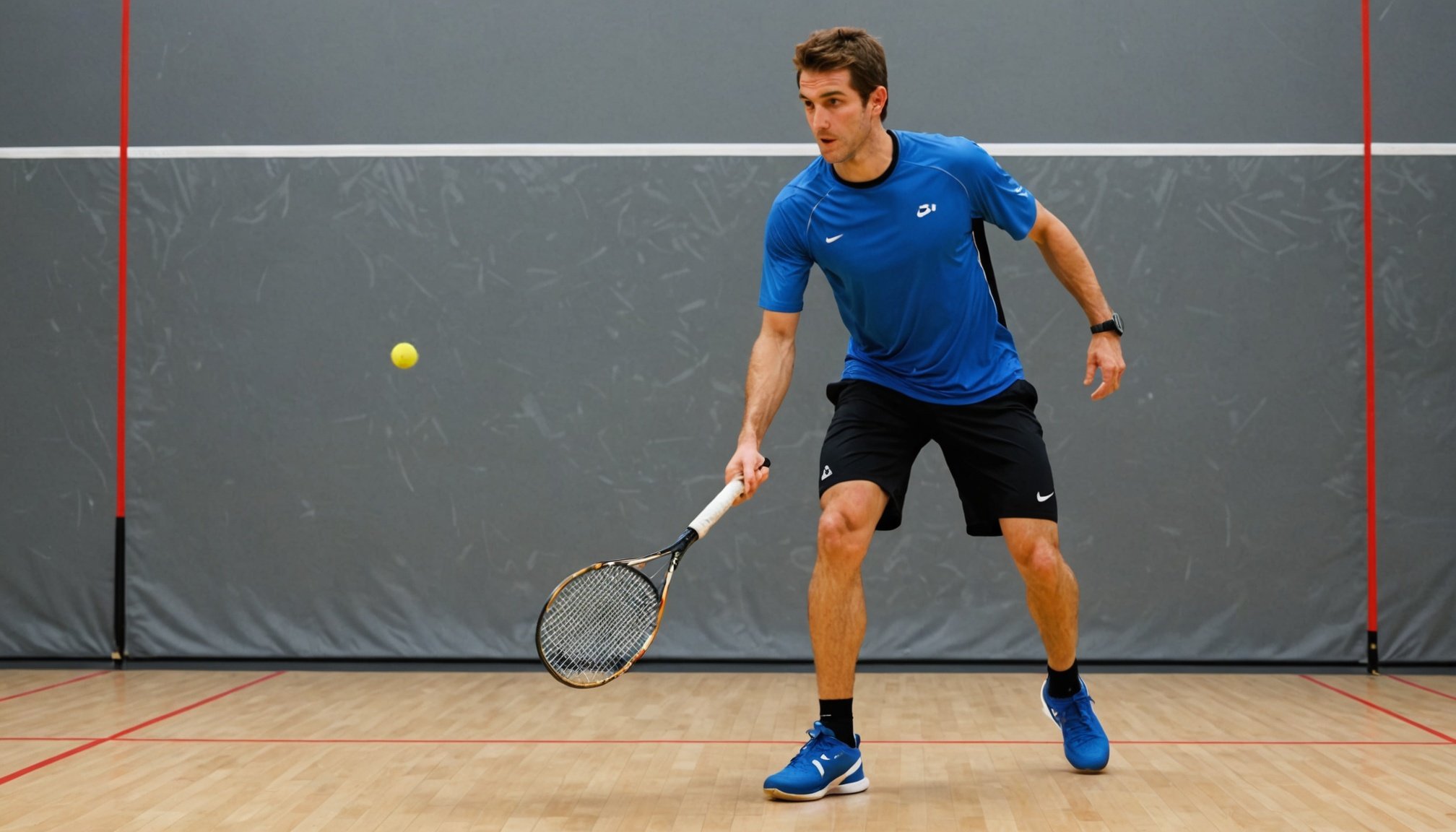Top Footwork Drills Every Squash Player Should Master for Peak Performance
The Importance of Footwork in Squash
In the fast-paced and physically demanding sport of squash, footwork is often the difference between victory and defeat. It is the foundation upon which all other skills are built, including shot execution, court coverage, and overall performance. For squash players, mastering footwork drills is not just about moving around the court; it’s about optimizing every aspect of their game.
“Footwork is the key to success in squash. It allows players to get into position to hit shots, recover quickly, and maintain a high level of intensity throughout the match,” says Tim Bacon, a renowned squash coach and AASP Charter Member.
Also to see : Essential Dietary Changes for Wrestlers to Optimize Weight Cutting Success
Establishing a Solid Training Routine
To improve footwork, squash players need to incorporate a variety of drills into their training routine. Here are some essential components to focus on:
Core Skills and Agility
- Shuttle Runs: These drills mimic the back-and-forth movement common in squash. Players start at the ‘T’ (the intersection of the service and doubles courts), sprint to the front wall, and then back to the ‘T’, repeating this process several times.
- Lateral Movements: Squash involves a lot of side-to-side movement. Drills such as lateral shuffles and carioca drills (alternating feet in a zig-zag pattern) help improve speed and agility.
- Forward and Backward Sprints: Sprinting from the ‘T’ to the front wall and back helps build the explosive speed needed to cover the court quickly.
Mental Preparedness
While physical training is crucial, mental preparation is equally important. Here’s how mental training can help:
Also read : Top Energizing Breakfast Ideas for Your Early Morning Workouts
- Visualization: Players can visualize themselves performing perfect footwork, anticipating shots, and moving efficiently around the court. This technique helps build mental resilience and a positive mindset.
- Pre-Match Routines: Establishing a consistent pre-match routine can help players focus and prepare mentally for the physical demands of the game.
Key Footwork Drills for Squash Players
Here are some detailed footwork drills that every squash player should master:
1. The ‘T’ Drill
- Description: Start at the ‘T’, sprint to the front wall, then move to the back wall, and finally return to the ‘T’.
- Benefits: Improves overall court coverage and endurance.
- Tips: Focus on quick turns and explosive acceleration.
2. Lateral Shuttle Drill
- Description: Set up two cones or markers about 10 feet apart. Start in the middle and shuffle laterally to one cone, then to the other, mimicking the side-to-side movement in squash.
- Benefits: Enhances lateral speed and agility.
- Tips: Keep knees slightly bent and weight evenly distributed between both feet.
3. Box Drill
- Description: Imagine a box on the court with corners at the ‘T’, front wall, back wall, and the service box. Move from one corner to the next in a continuous loop.
- Benefits: Improves overall court coverage and agility.
- Tips: Focus on quick changes of direction and maintaining a low center of gravity.
4. Ghosting Drill
- Description: Practice moving around the court as if you are playing a match, but without a ball. Focus on perfecting your footwork, including approaches to the ‘T’ and recoveries.
- Benefits: Enhances court awareness and movement efficiency.
- Tips: Visualize the ball and anticipate where it would be, just as you would in a real match.
The Role of High-Intensity Interval Training
High-intensity interval training (HIIT) is another critical component of squash training that can significantly improve footwork and overall performance.
Benefits of HIIT
- Improved Anaerobic Capacity: HIIT helps in developing the anaerobic energy system, which is crucial for the intense, short bursts of energy required in squash.
- Enhanced Sprinting Abilities: By incorporating sprint intervals into your training, you can improve your ability to cover the court quickly and delay the onset of fatigue.
- Time Efficiency: HIIT sessions are shorter than traditional endurance training but offer comparable or even superior benefits, allowing more time for sport-specific skills and tactics.
Table: Comparing Traditional Endurance Training with HIIT
| Training Method | Duration | Intensity | Benefits | Time Efficiency |
|---|---|---|---|---|
| Traditional Endurance Training | 45 minutes, 3 times a week | Moderate (75% VO2max) | Improves aerobic capacity, but less effective for anaerobic gains | Less time-efficient, requires more overall training time |
| High-Intensity Interval Training (HIIT) | 15-20 minutes, 3 times a week | High (90-100% HRmax) | Improves both aerobic and anaerobic capacity, enhances sprinting abilities | Highly time-efficient, reduces overall training time by up to 90% |
Practical Insights and Actionable Advice
Nutrition and Recovery
Proper nutrition, hydration, and adequate rest are vital for optimal performance. Here are some tips:
- Balanced Diet: Focus on a balanced diet rich in proteins, carbohydrates, and healthy fats to support muscle recovery and energy production.
- Hydration: Stay hydrated before, during, and after matches to maintain peak physical performance.
- Rest and Recovery: Ensure sufficient sleep and incorporate recovery techniques such as stretching and foam rolling to avoid injuries and maintain physical fitness.
Mental Training
Mental training is as important as physical training in squash. Here’s how you can integrate it into your routine:
- Visualization and Mindfulness: Practice visualization techniques to improve your mental resilience and focus. Mindfulness exercises can help manage match nerves and maintain a positive mindset.
- Pre-Match Routines: Develop a consistent pre-match routine to help you stay focused and prepared mentally for the match.
Examples from Squash Legends
The careers of squash legends like Nicol David, Laura Massaro, Nick Matthew, and Chris Binnie serve as testament to the importance of early and consistent training, including footwork drills.
- Nicol David: Before becoming an eight-time World Champion, Nicol David honed her skills through rigorous junior tournament participation, which included a strong focus on footwork and physical conditioning.
- Nick Matthew: Nick Matthew’s journey from junior tournaments to three-time World Champion highlights the impact of sustained dedication to training, including footwork drills that developed his strategic prowess and physical strength.
Final Thoughts
Mastering footwork drills is a continuous process that requires consistent training, mental preparation, and a balanced lifestyle. By incorporating these drills into your training routine, you can significantly enhance your performance on the court.
“Footwork is not just about moving; it’s about moving efficiently and effectively. It’s the foundation of every great squash player,” says Tim Bacon.
In conclusion, whether you are a junior player just starting out or an experienced athlete looking to refine your skills, focusing on footwork drills will help you achieve peak performance in squash. Remember to combine these drills with high-intensity interval training, mental preparation, and a healthy lifestyle to become a well-rounded and formidable squash player.











